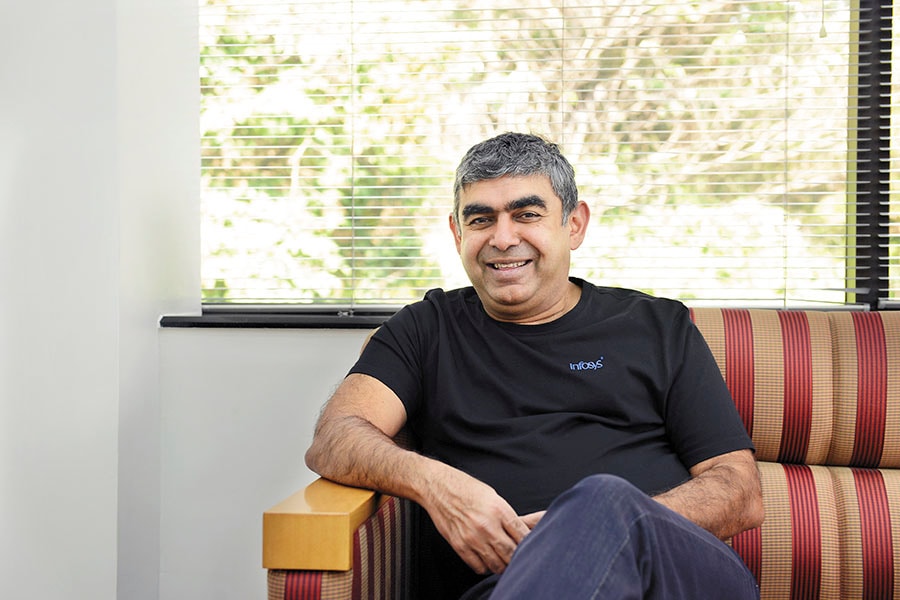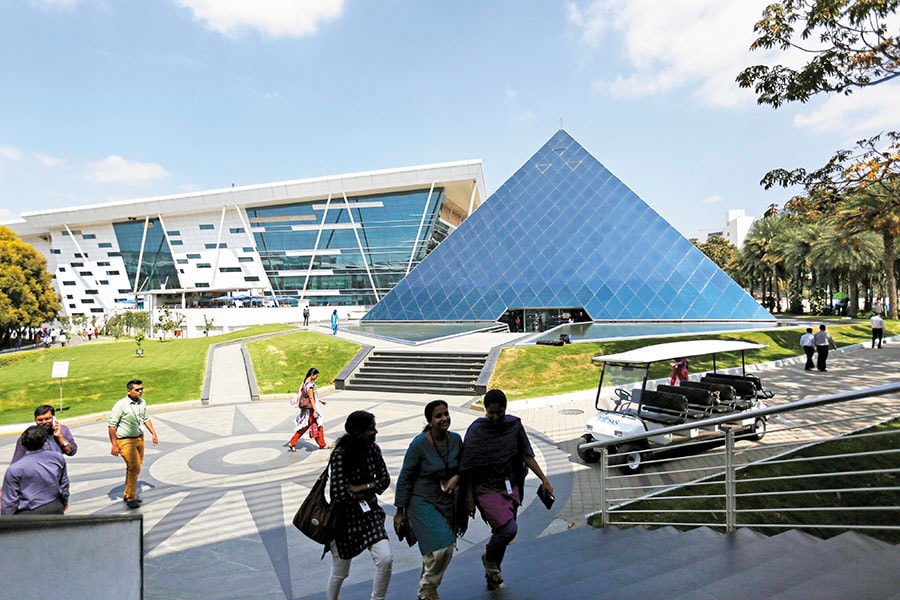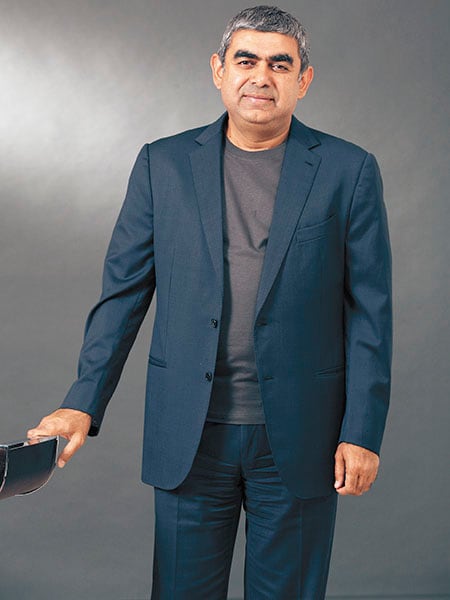
There is a deep-rooted sense that we are on the right path: Vishal Sikka
Infosys's Vishal Sikka has resigned as MD & CEO on August 18, 2017. In one of his most recent interviews (published on May 8) with Forbes India, Sikka spoke about how the company was disrupting itself to prepare for an automation-driven world.
 'A disruption shakes things up in an industry and produces something new and more efficient,' says Vishal Sikka
'A disruption shakes things up in an industry and produces something new and more efficient,' says Vishal Sikka
Image:Hemant Mishra / Mint via Getty Images
The old outsourcing model is fast disappearing and Indian information technology companies are riding a tsunami of intimidating change. Infosys for its part is dealing with change by not only tweaking its business model, but hiring aggressively in the US to avoid being held hostage to perennial H-1B visa issues. Infosys is planning to build four technology and innovation hubs, and has already settled on one in Indiana, the home state of American Vice President Mike Pence.
A consummate technologist, Vishal Sikka, CEO of Infosys Limited is not only committed to growing the company’s footprint in the US, but looks at the world with the eyes of a disruptor. “Disruption is inevitable but it is often deeply feared. A disruption shakes things up in an industry and produces something new and more efficient,” says Sikka from his Palo Alto office. “At Infosys we are reinventing and disrupting ourselves by embracing automation. In a world where everything is changing, the biggest risk is standing still.”
Sikka, 49, was hired in 2014 to renew a struggling Infosys. Instead of just chasing back-office contracts, Sikka is trying to transform Infosys into a global software and high-margin consulting business. He has been connecting the dots of opportunity by getting Infosys to disrupt itself by adopting a wide range of technologies to potentially automate iterative computation frameworks, operation and maintenance, and BPO activities. For Sikka, automation is about enabling higher productivity.
He is trying to create a carpe diem moment for Infosys by reinventing the company around the holy grail of artificial intelligence (AI). Infosys just launched its second generation AI platform Nia to score new deals with clients in its biggest market, North America.
“Artificial intelligence is fundamental to our future,” says Sikka, who grew up in India, and moved to the US at the age of 19. He went to Stanford University, where he received his doctorate in artificial intelligence and was taught by cognitive scientist John McCarthy who is regarded as the father of AI.
A thoughtful risk-taker, Sikka is reorganising Infosys around automation and AI based on strong business imperatives. A recent survey of 1,600 global enterprises by Infosys found that 71 percent of their leaders feel the adoption of AI in business and society is inevitable; and a quarter have already fully deployed at least one AI technology.
Doggedly persistent, Sikka has considerable street cred in Silicon Valley as a disruptor for creating German tech giant SAP’s HANA Enterprise Cloud platform. He also built two successful startups: iBrain, which he sold to PatternRX, and Bodha.com, which he sold to Peregrine Systems.
Infosys had revenues of Rs 68,484 crore ($10.2 billion) in FY16 and expects it to grow by between 6.5 percent and 8.5 percent in constant currency terms during 2017-18. It reported a small rise in consolidated net profit to Rs 3,603 crore ($543 million) in the three months to March, from Rs 3,597 crore ($533 million) in the year-ago quarter. Sikka expects America to see stronger investment cycles and is positive on the company’s financial services business. US stock fund Oppenheimer Funds reinstated its “market perform” rating on Infosys as the Indian tech firm gets a majority of its revenue from the banking and financial services industry, which is tipped to do well in 2017.
Sikka spoke to Forbes India about his strategy to help Infosys thrive and grow amid industry disruption and the new path forward.
Q. US President Donald Trump has issued an executive order reviewing the H-1B visa programme. Are you bracing for tightening of US immigration laws and concerned about proposals in Congress regarding H-1B visas?
To begin with, I am a very senior local US hire! It’s path-breaking that several members of the Infosys senior team are based on the West Coast. It makes sense for us to be here near some of our biggest customers. The five biggest tech firms in the world are just 20 miles up and down the coast. We have received positive feedback from our US customers, they like us being in their line of sight. I have lived in California for the last 29 years. It was a fundamental part of my journey to be here at the heart of innovation.
We have just announced that we are hiring 10,000 Americans over the next two years and opening four new technology and innovation centres in the US. Ever since I started we have really emphasised local hiring and put a lot of programmes in place around this not only in the US, but also in Europe, Australia and other countries. We are already doing a lot of campus hiring from US universities.
This whole visa-centricity is something we need to abandon. We need to have a healthier mix of local hiring and training. My view is that we have to stay focussed on innovation rather than worry about any regulatory or visa pressures for the industry.

Image: Vivek Prakash / Bloomberg via Getty Images
Q. Is it good for business that you as the Infosys CEO are based on the West Coast?
It certainly doesn’t hurt to be based here when 60 percent of our business comes from North America. It does make a huge difference in executing deals.
Q. How important is your main market of North America in your growth strategy? In the US we’ve seen a couple of rate hikes and an easing of regulatory pressure so do you expect some of the client spending to come back later in the year?
North America is our most important market and will be for the foreseeable future as the US economy drives global growth. On the regulatory side, there are dual forces at work here. At one level, there’s easing of regulatory pressure and US companies feel the need to remain competitive by innovating. I see a tremendous jump in demand for digital and AI solutions whether you look at the financial sector, retail, manufacturing, energy, or health care. The need for innovation has never been stronger so there’s a tremendous amount of opportunity for Infosys. We remain fairly confident on financial services. At the same time, there’s a strong need for lowering costs on managing the existing businesses, and this is getting stronger. So we must address that as well; some of our work is also affected by this. But that is the normal course for disruption; we must grow with the new, as we renew.
Q. Do you favour an internally focussed organic approach to growth or growth by acquisition?
We are going to do both. You can’t overdo either one—if you only grow internally you become terribly insular, but if you do too much of the other you become too discordant and lose a sense of identity and purpose. You need a continuous influx of new DNA, new blood, new talent, diversity.
Q. Does the $2.02 billion cash return to shareholders announced in April leave you with a war chest to do major acquisitions?
After the capital allocation we have plenty of cash to acquire new companies. No compromises on that front.
Q. While Infosys’s margin management and cash conversion are positive, how will you increase the growth trajectory?
Our growth strategy is simple—it’s to move the bulk of our programmers into the high-revenue producing bucket by using automation to do the maintenance and operation stuff. We see an opportunity to achieve higher productivity and innovation, and accomplish what Professor Raghunath Mashelkar [an eminent Indian scientist] described as “doing more with less, for more”. We are building Infosys into a next generation services company.
Our new software revenue is about $150 million. That business is growing rapidly at a higher revenue per employee [RPE] clip than the non-software business. By doubling down on our software business and new areas of focus like automation and AI we will achieve growth. In a span of a year, Infosys products like Mana and AssistEdge gathered over 50 clients, over 150 engagements across industry sectors. Our new AI platform Nia will provide clients even bigger AI solutions.
Non-linear growth is not easy—you have to get into the software business and the intellectual property oriented business. For the first time in a measurable and meaningful way that business is kicking in for Infosys.
Q. The largest US stock fund focussed on emerging markets, Oppenheimer Fund, said in a public letter that “Let Vishal do what he was hired to do, without distractions. And appraise him on his efforts.” Care to comment.
Justin [Leverenz, of Oppenheimer] and his team believe in what we are doing, as do a lot of others. Everyone understands that a fundamental shift in our business is happening and the trajectory of the company must change. There is a deep-rooted sense that we are on the right path and the board is very supportive. Debate and discussion take place in all well-run companies, and it is only natural that their pitch will increase when external pressures heighten. We continue to execute on our strategy with the full backing of the board and that is what allows us to be so purposeful and confident.

Q. In an era of AI and automation where the old outsourcing model is fast disappearing, what is Infosys’s strategy?
I have spent my life looking into AI. I have studied at the feet of the masters and pioneers of AI. Marvin Minsky, one of the fathers of AI, wrote my recommendation letter for my admission to Stanford. John McCarthy—the man who coined the term and pioneered the field of AI research—was one of my teachers.
Today, if you look at Infosys, we have 65 percent of our workforce producing 55 percent of our revenue from areas which are rapidly commoditising. Areas in maintenance, operations, and things of that nature which are under tremendous margin and cost pressure. The revenue growth isn’t strong and those jobs are prone to automation. In the next five years, 75 percent of those jobs are going to be replaced by automation. Then there is 35 percent of our workforce which produces 45 percent of our revenue. That grew 20 percent last year and that business has close to 30 percent margins.
The RPE in the first category is $48,000, while the RPE in the second category is $72,000. So our story—to borrow a title from Charles Dickens—is a tale of two cities. There are huge parts of our workforce engaged in functions that are going to see rapid automation. Therefore, we have to reinvent ourselves as ‘Masters of Automation’. We have to not only take advantage of automation, but build out automation systems.
AI is fundamental to our future, that is why we have just introduced a next-generation AI platform, Nia, to strengthen our digital technology services. Nia builds on Mana, our original AI platform. It also includes the robotic process automation capabilities of AssistEdge. We are bringing Nia into our own world—to the 65 percent of the workforce that I mentioned earlier who are into maintenance, operations and the BPO business—to bring dramatic productivity improvements, improve margins. The other half of our Nia platform is where we bring AI solutions to our customers related to forecasting, understanding customer behaviour very deeply, detecting fraud on a continuous basis, using sophisticated AI-based techniques to do better R&D.
Infosys is rethinking its training infrastructure and augmenting it with, for example, short courses or “nanodegrees” to help drive the rapid acquisition of new skills, including AI techniques, at scale.
Q. Can you give examples of how AI has helped Infosys learn its clients’ business and helped them improve their competitiveness?
We have worked with a lot of banks in India to detect fraud. After demonetisation there was a huge amount of fraud that happened where people opened up a large number of fake accounts. How do you detect fake accounts? We used AI to crack the new techniques that people use to carry out bank fraud.
Q. How does Infosys plan to meet its $20 billion revenue target, which is a near doubling of its revenues in three years?
This is our aspiration. I articulated this target in October 2014 for the first time as a sort of rallying cry. We want to get to $20 billion in revenue which means we want to grow our revenue rapidly by aggressively going after new opportunities.
We want to get to 30 percent margin, which means we want revenue to grow with consistent high profitability and increase our RPE to $80,000. What good is an aspiration if it is not difficult? In fact, if your vision doesn’t challenge you, it won’t change you. And we are very clear that this new technology paradigm demands that we change.
Q. Infosys has over 2 lakh employees, and in eight years millennials will comprise the majority of the workforce. What are some of the ideas you are using to recruit millennials?
The biggest thing I found in attracting young people is imbuing a sense of purpose. More than compensation, it is a sense of purpose that draws good talent. Every time I go to Mysore or do one of those Zero Distance meetings with the project team there’s such incredible positive energy and enthusiasm among our younger employees. The opportunity to spend time with young engineers keeps me open to new ideas. That is what drives me.
If you look at our attrition among high performers, it has come down to single digits, and overall attrition now is 13 to 14 percent. Overall attrition was at 24.9 percent when I started out at Infosys, and it was even higher among high-performers. It is a remarkable shift.
(This story appears in the 30 November, -0001 issue of Forbes India. To visit our Archives, click here.)




